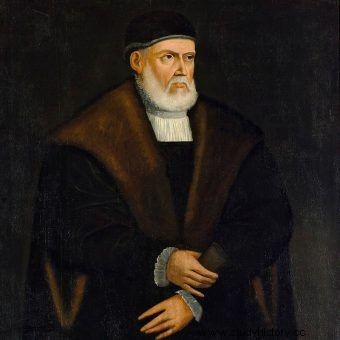
Portrait of Zygmunt Stary, most probably by Marcin Ostrowski.
Sigismund I the Old
The King of Poland and the Grand Duke of Lithuania from the Jagiellonian dynasty. He was the fifth son of Kazimierz Jagiellończyk and Elżbieta Rakuszanka. With numerous, older offspring, his parents did not anticipate a great political career for him and did not prepare him for the role of king. Zygmunt the Old only held the position of governor of Silesia and Lusatia from 1504, which was granted to him by his brother Władysław, who ruled in Hungary and the Czech Republic.
He was appointed King of Poland and the title of Grand Duke of Lithuania after 1506, after all his competitors to power died prematurely:Kazimierz, Jan Olbracht and Aleksander Jagiellończyk. In connection with his accession to the throne, he ended his long, though non-sacramental relationship with the Moravian townswoman Katarzyna Telniczanka, who bore him two children. He married the Hungarian aristocrat Barbara Zapolya, but she died quickly.
Zygmunt the Old turned out to be a not very resolute and extravagant monarch, but he was passionate about art and the trends of the Renaissance. It was he who rebuilt the Wawel castle (including the Sigismund Chapel), the effects of which can be admired to a large extent to this day. In 1525, he also accepted the fiefdom of prince Albrecht Hohenzollern (the last Grand Master of the Teutonic Order) - so they became legends and the "Prussian Homage" perpetuated by Jan Matejko. In 1526, he incorporated into the Polish borders only the principalities of Masovia, which had been loosely connected with it, which, several dozen years later, allowed the country's capital to be moved to Warsaw.
The second wife, Bona Sforza, who came from the south of Italy, had a great influence on the life of the king of Poland, especially in later years. Already during the lifetime of King Zygmunt ("vivente rege"), his son and namesake, Zygmunt August, was crowned king. This decision, forced by the royal wife in 1530, meant that the father was referred to as Sigismund I the Old. The ruler died on April 1, 1548 in Krakow and the authorities were taken over by Sigismund Augustus.
